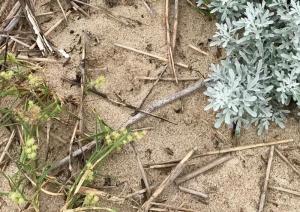Beachcombing after a weekend storm, thinking about plastic
Short conversation on the bay beach at Cape Henlopen State Park.
“Finding any?”
“No.”
It was Sunday afternoon following a break in the weather. Three inches of rain between Saturday and Sunday morning. My friend Albert, who lives along the Rappahannock River on the Northern Neck of Virginia, said they had 12 inches of rain between noon and 7 p.m. Saturday. “Never seen anything like it in my life.”
More on the way with Florence bearing down on the East Coast this week.
But on Sunday afternoon, the rain had eased, the winds let go, and people came back outside.
The man I spoke with was clamming along the water’s edge. His wife was taking a break, her rake by her side where she sat on the beach. Farther along, the receding tide revealed a sandy flat where a blue heron stood, looking like he was walking on water.
“Have you tried clamming on the flats?” I asked her. “May be some razor clams out there.”
“We’ve tried them,” she said. “But they go down so fast they’re hard to catch. As soon as they feel that rake in the sand they’re gone.”
Seems improbable, but then I’ve never heard of people having much luck catching the razors. Not that they aren’t worth the effort. They have a load of meat in them. But clamming for them is just not as productive as it is for hard clams.
I walked toward the point, stepping carefully through the tideline, looking for whatever the stirred-up weather may have deposited, keeping a close eye out for the beach burrs and their sharp, barbed points. Despite my caution, one found its way into the soft part of my bare foot. Then the double whammy. Pulling it out meant extracting the little barbs from my foot knowing that in the process the barbs on the other side would go into my finger. Only one way to do it: quickly, like ripping off a Band-Aid. Quick hurt, quick over.
The heron watched from a distance, quiet, unmoving.
Walking along and looking carefully, I noticed that most of what I saw was natural: shells, pieces of horseshoe crabs, lots and lots of browned stems from last winter’s dead marsh grasses. I was pleasantly surprised there wasn’t more plastic. There were a few items: a couple of toy trucks, a few spent shotgun shells, a few bits of styrofoam - but no straws.
Maybe some of the effort is taking hold. We have this magnificently abundant and beautiful world. The most important thing we can do is take good care of it, for ourselves and future generations. If we do, it will take care of us.
About the straws
A few weeks back I was drinking a beer at a pizza joint and the man next to me was drinking iced tea. He was handed a plastic straw in a white-paper wrapper. He snickered. “I hope that’s not the kind that goes up turtles’ noses.” Then he paused and took a sip.
“That’s all a bunch of bunk as far as I’m concerned,” he said. “I should be able to use a plastic straw if I want. The problem isn’t with the straws. We just need to keep them out of the waterways. I don’t think it’s as big a problem as people are making it.”
I thought about that island-sized floating mass of plastic and other debris I’ve heard about that’s drifting around in the South Pacific. We know damn well there’s too much trash and litter being dumped in the oceans and further fouling our planet.
“You might be right about the extent of the problem with the straws,” I said. “But I’ve seen photographs of turtles and seabirds fouled and strangled with fishing line and the plastic binding rings off of soda and beer six-packs. The important thing to me about the movement to ban plastic straws is that younger generations are showing they care. And when they’re showing that kind of care, I want to support and encourage them all I can.”
So, for that reason, I was happy to see less plastic on the beach Sunday afternoon than I expected to see.
I also saw less of something else that I expected to see. Weather, storms, tides and currents are making short work of the fishing pier in Cape Henlopen State Park.
It seems like less than 20 years ago, the wharf at the end of the half-mile pier was solid, and improved with benches, with the huge cleats still in place for large vessels that tied up occasionally. Servicemen loaded mines on vessels there for deployment in the mouth of Delaware Bay during World War II. Occasionally you’ll see photographs around the area of the German U-boat that was captured and brought in there near the end of the war.
But the wharf is long gone now, and more than half of the pier is reduced to scattered pilings.
Pieces of the structure also show up on the beach these days - stout pieces of timber run through with two-inch bolts.
Nature keeps its show running - the longest-running show of all. Always predictable in its unpredictability. We’ll see what we’re left with next weekend after the effects of Florence visit us.





























































